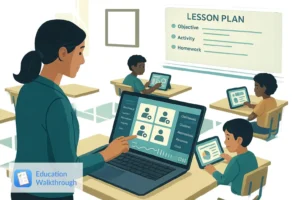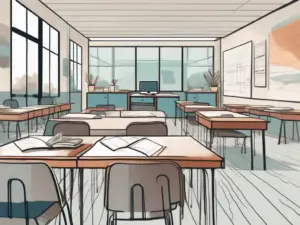Classroom walkthroughs are a tool to observe teaching as it occurs in a learning environment. Classroom walkthroughs are usually performed by administrators, teachers, or other educational experts. The point of classroom walkthroughs and observation is to analyze teacher performance and give them actionable feedback on their techniques. In that sense, classroom observations and walkthroughs are often part of teacher evaluations.
Classroom walkthroughs can be informal or more formal. They can also use several different observational models that focus on different aspects of teacher instruction and student performance. Most of the time, school districts and individual schools will have some kind of set guidelines for performing classroom walkthroughs, whether in a formal or informal context. The key purpose of classroom walkthroughs is for data analytics that can help improve the teaching process.
Classroom observations can also be short, totaling no more than 15-30 minutes, or long and lasting for an entire day. Informal walkthroughs tend to last a shorter time and may have more focused observational criteria.
In most cases, classroom walkthroughs are for making school improvements to curriculum or teacher training/evaluation. In that sense, walkthroughs are often focused on instructional quality, learning assessments, and teaching effectiveness. Walkthroughs can be performed by other teachers from the same grade level or by school administrators.
Many teachers work on their own, and so end up creating idiosyncratic lesson plans and teaching styles. As such, teaching styles and teaching effectiveness can vary between districts and even between classrooms in the same school. Classroom walkthroughs and observations are a method to address these problems of non-standardized instructional techniques and methods. Often, classroom walkthroughs are performed as part of a teacher’s professional development.
Formal vs. Informal Walkthroughs
Formal walkthroughs are normally conducted over a longer period and usually give the teacher ample time to prepare for the observation. While they can be useful, many critics point out that, since formal observations are often pre-scheduled, teachers have time to explicitly prepare for them. Consequently, what is observed may not reflect the daily reality in the classroom.
Informal walkthroughs, on the other hand, are more spontaneous and are usually not scheduled in advance. Since they are more organic., informal shorter walkthroughs can often give teachers and school administrators a more accurate picture of how the classroom operates on a day-to-day basis. They can also reduce the pressure on teachers as informal observational contexts are generally more relaxed and less stringent.
Benefits of Classroom Walkthroughs
Classroom walkthroughs are a key tool that many districts use to improve teaching effectiveness and teacher performance. Here are just a few of the noted benefits of classroom walkthroughs.
Instructional Focus
One of the goals of classroom walkthroughs is to clarify and narrow down what kinds of aspects teacher instruction should focus on. Whether its learning effectiveness, student performance, or student-teacher interactions, classroom walkthroughs can be focused on specific aspects of teaching and identify which aspects of instruction need more emphasis and focus. In other words, the goals of classroom walkthroughs are to ensure everyone is on the same page when it comes to instructional goals.
Common teaching language
As we stated earlier, one problem many districts face is that, since teachers work independently of each other, they often come up with different teaching strategies or techniques. Teaching effectiveness can thus differ between classrooms in the same building. What classroom walkthroughs do is help create a common teaching language for a school or entire district.
The main benefit of establishing a common teaching language is that it helps avoid confusion or misunderstanding during team meetings and professional development contexts. For example, if teachers are using different language and terminology to teach the same concepts, then students might get confused and performance will suffer.
Also, having a common core technique smooths student transitions from one learning environment to the next. It is a way to ensure a kind of uniformity among teaching standards that ultimately allows students to be more successful.
It establishes a healthy culture
Classroom observations are often used as a way to gauge teacher performance. Constructive criticism and observation is a good way to give teachers positive feedback that can help them improve. Most employees want to hear feedback on their performance. There is quite a bit of evidence demonstrating that a lack of actionable performance reviews is a major cause of employee turnover, regardless of the industry.
Walkthroughs not only help teachers become better and keep them happy, but they also give administrators and those who may not spend as much time directly in the classroom a first-person view of how the classroom functions. This, in turn, allows for a better relationship between teachers and administrators as it builds trust and respect.
Debates on Classroom Walkthroughs
Classroom walkthroughs and observations are not without their detractors and critics, though. The main criticism is that different administrators and teachers might have differing opinions about how classroom observations should work and what kind of evaluation criteria should be used.
Additionally, some criticize classroom observations because they feel they are not effective in achieving their goals. This could be due to many reasons, including but not limited to:
- Administrators and teachers might not be using reliable, peer-reviewed, observational strategies and techniques. Observation is a science, and random, unfocused observations can be unhelpful.
- Observers themselves may lack the necessary background knowledge to properly implement observational standards.
- In the case of pre-scheduled observations, teachers might alter their teaching strategies and techniques, which paints an inaccurate picture that is not representative of normal teaching conditions.
- Feedback may be vague, unhelpful, or lack and context or guides for improving teaching performance.
Aside from these reasons, some may feel like classroom observations are unnecessary or may take umbrage with the specific people in charge of observing.
Regardless of the reasons for criticism, there is a growing body of evidence that classroom observation, when applied properly, can help improve teaching. By studying teaching in a naturalistic setting, lessons can be gleaned to help improve the overall teaching process.






